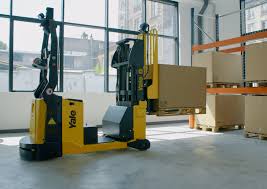Source: roboticsandautomationnews.com
The 100-year-old locksmith’s company partners with Balyo to offer robotic solutions such as autonomous forklift trucks for the material handling industry.
Yale Europe Materials Handling says it now offers “sophisticated robotic solutions” which can adjust to changes in their surroundings.
All trucks in the Yale robotics range can be linked to a warehouse management system and feature a touchscreen interface to give instructions to the robot.
Yale adds that its robotic solutions also offer manual operation at the touch of a button.
Working with the robots
Robotics and humans working together, the workforce of the future – or is it? For the materials handling industry, this is already possible.
Ron Farr, warehouse solutions manager for Yale, says: “Many people might believe robots in logistics are in their infancy.
“At Yale, we’ve implemented the technology and software in order to offer sophisticated robotic solutions that can adjust to changes in their surroundings, for greater flexibility than solutions that require dedicated navigation infrastructure.”
How the robot interacts with its environment
The Yale robotics MC-10-15 counterbalance stacker can interact with and access pallets at height – for example, on conveyor belts or second or third shelves up to a height of 1.8 meters.
The front laser allows the robot to sense the pallet, and the barcode scanner identifies the correct pallet to fulfil the instruction.
Farr says: “The Yale robots, driven by Balyo geoguidance technology, are fitted with advanced obstacle detection technology which enables it to react to the situation.
“Once the robot has detected something ahead, it can control its speed in a smooth and efficient movement to minimise stops and shocks, slowing down to a complete stop if needed.”
An additional rear scanner is installed for instances when the counterbalance stacker is travelling in the forks-forward direction. A curtain laser scans for additional above-ground obstacles, while side lasers provide a full 360 degree coverage at all times.
Farr says: “The robot also informs those working in the environment of its status, emitting an audio warning and projecting a blue LED spotlight on to the ground when it is in motion.
“A light mounted at eye-level flashes if the truck is about to turn, which flashes more rapidly while the truck is completing a turn.”
Ease of communication
All trucks in the Yale robotics range, which includes the MO50-70T robotic tow tractor and MO10-25 low level order picker, feature a touchscreen interface to give instructions to the robot, and can all be switched to manual mode at the touch of a button to complete tasks outside of the truck’s pre-programmed parameters.
Logistics operators can interact with the robot with real-time truck management. The software can integrate with existing Enterprise Resource Planning (ERP) and Warehouse Management Systems (WMS).
Farr says: “The software can be used to assign tasks to individual trucks and is used to control the flow of traffic.
“The robotic solutions can be linked to other equipment in the warehouse, for example the conveyers can call the robot to remove a product. Fire alarms can tell the truck to stop in a safe area that does not hinder pedestrians exiting.
“Warehouse Managers can schedule the charging of the robots, which enables the use of cheaper night time rates.
“The trucks can go on charge on rotation, rather than all the robots arriving at lunchtime. This can help with the running costs of the vehicle, as well as maintenance, as it’s all very predictable.”
Reduced training time
Training new employees can be time-consuming, but by integrating robotics solutions into applications companies can reduce the time it takes new‑hires to get up to speed.
Adopting automated solutions can help applications simplify tasks reserved for employees and foster a collaborative environment. In goods-to-operator fulfilment workflows for example, employees can focus on picking and packing orders as quickly as possible from inventory, brought to them by a robotic solution.
The Yale MO50-70T robotic tow tractor offers horizontal transportation over short and long distances, and brings individual items together as one unit to employees that require them.
Interconnectivity expands to the wider infrastructure too – sensors on conveyor belts can be used to detect pallets at the end of the line and call for the robotic solution to collect the pallet to transport it to its next location.
Robotics trucks are ideal for performing repetitive tasks such as movement of pallets in the warehouse environment and loading and unloading.
The MO25 low level order picker offers cost efficient transfer and a regular, sustained constant flow, taking care of stock replenishment and transporting goods.
Farr says: “Robotics can liberate employees to conduct tasks that humans do best.
“Having robots working alongside humans leverages the strengths of both to make repetitive tasks and more complex, value-added functions more efficient.
“It can also provide new opportunities for people with physical limitations to serve as integral parts of the process, as robots can move inventory to pickers and help keep the operation flowing.
“Autonomous solutions drive proven cost savings by increasing labour efficiency, reducing turnover, extending asset life and increasing throughput. What really solidifies them as a smart investment is their flexibility.
“It enables practical accommodation for manual intervention, minimises ongoing costs in the event of minor layout adjustments and the need to supplement future initiatives such as Industry 4.0.”
Yale says that, working in unison, the company’s “sophisticated robotics solutions are ready to be deployed in appropriate applications, working in harmony with humans to drive productivity”.


